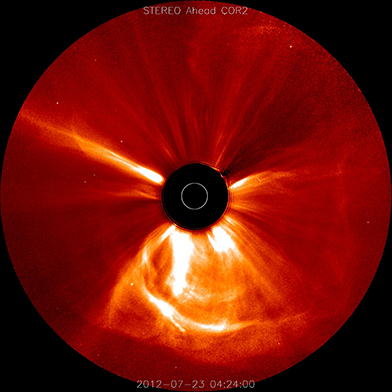A new mission to unveil the mechanisms behind some of the Sun’s most explosive outbursts was selected as one of four new CubeSat missions for NASA’s Heliophysics Flight Opportunities in Research and Technology program, the agency announced in December.
Led by research scientist and aerospace engineer James Mason at the Johns Hopkins Applied Physics Laboratory (APL) in Laurel, Maryland, the Sun Coronal Ejection Tracker, or SunCET, mission aims to fill a persistent gap in our physical understanding of coronal mass ejections, or CMEs, while also providing a testbed for space weather monitoring and innovation through a small satellite.

“For the first time, from Earth’s perspective, we’re going to have an uninterrupted view of how CMEs are born, accelerated and ultimately progress out into space — an ability we briefly had in the 1990s with the SOHO [Solar and Heliospheric Observatory] mission but lost after a technical failure and never had again,” said Dan Seaton, a solar physicist with the Southwest Research Institute in Colorado and the project scientist on the SunCET mission.
CMEs are enormous clouds of entangled magnetic fields and hot, charged atoms and electrons (called plasma) that burst from the Sun’s blazing atmosphere at speeds of up to almost 1,900 miles per second (3,000 kilometers per second). Every month, an average of roughly 100 of these explosions blast billions of tons of particles with 10 times the energy of the asteroid impact that wiped out the dinosaurs. Those directed at Earth can wreak havoc on its “technosphere” — from interrupted GPS signals, to knocked out airplane communications systems and blackouts on the ground — and pose potentially lethal hazards to astronauts.
“It’s difficult to forecast when the eruptions will occur and when they’ll arrive at Earth in part because there’s a critical gap in our ability to see them,” said Mason. “The issue is largely a lack of the right data to make robust predictions.”
When CMEs erupt, a period of acceleration close to the Sun’s surface rapidly propels the particles into space. Physicists have suggested several possible mechanisms for this sudden propulsion, but the actual one is a mystery because of a major limitation of previous imagers: their dynamic range.
Try taking a photo with a smartphone during sunrise or sunset and you’ll understand the problem. Tap the screen to focus on the foreground, and the sky appears too bright and blown out (or overexposed, in photography parlance); tap the phone to focus on the sky, however, and the foreground turns too dark (or underexposed). Smartphones can mitigate this effect slightly by photographing with high dynamic range (or HDR), but most cameras cannot handle an extreme contrast between bright and dark sections.
A simulation video of the view that NASA’s new SunCET mission will have of an exploding CME. The video also illustrates the important current region around the Sun where unknown mechanisms accelerate CMEs into space. The SunCET mission aims to fill this gap. (Credit: James Mason/Dan Seaton/Meng Jin)
Imagine how much worse the problem is when scientists try imaging the corona around the Sun and its blinding disk, which is 10,000-100,000 times brighter.
“It’s a problem of extreme dynamic range,” Mason said. “Either you saturate the solar disk or you can’t see the corona surrounding it.”
Most solar imagers have either focused on just the solar disk or blocked it out with coronagraphs to concentrate on just the Sun’s very faint corona. Yet in doing so, they’ve blocked out the region where CME acceleration occurs. Although multiple research groups have tried using post-processing techniques to merge the extremely bright and dark sections, it’s been challenging and riddled with caveats because of the way images were captured.
“That’s why our new simultaneous high-dynamic-range camera is the driving solution for the whole mission,” Mason said.
SunCET’s camera for imaging in extreme ultraviolet light carries a sensor that has been modified so its rows of pixels can be controlled independently. As detailed in a recent paper the team published in The Astrophysical Journal, this uniquely programmed sensor can take short exposures of the bright solar disk in one part of the sensor while simultaneously taking long exposures of the dim corona in other parts. By then using an onboard computer to make a composite from several exposures, SunCET can produce and return a complete view of an erupting CME.
“We’re going to see every CME, and my very strong suspicion is that SunCET is going to put to bed this idea that there’s just one cause of CMEs,” Seaton said. Every CME is unique, he added, and by observing them, scientists can understand their range of behaviors — an important asset not only for understanding how CMEs form but also for predicting their behavior.
The team sees potential applications for this method to astrophysics, planetary science and Earth science as well — anywhere there is a high dynamic range and events evolve quickly, Seaton said, but particularly where miniaturized detector and imagers will make exploring new regions (such as the Sun’s poles, which nobody has ever seen) accessible.
“Particularly for solar physics, this is really exciting,” he said. “It’s going to be a pathfinder for exploration of the Sun from deep space.”
SunCET is funded by the NASA Space Weather Science Activity through the NASA Heliophysics Flight Opportunities in Research and Technology program, which encourages the development of technologies that will enable the investigation of heliophysics science questions. The mission is jointly led by the Johns Hopkins Applied Physics Laboratory, which will develop the mission’s telescope, and the University of Colorado Boulder’s Laboratory for Atmospheric and Space Physics (LASP), which will provide the spacecraft bus, spacecraft integration and testing, and mission operations. NASA’s Goddard Space Flight Center, the High Altitude Observatory, the Southwest Research Institute, the Naval Research Laboratory, and the Northwest Research Associates will provide mission science support.
Related Topics
For Media Inquiries
For all media inquiries, including permission to use images or video in our gallery, please contact:
Michael Buckley
All Media Resources

